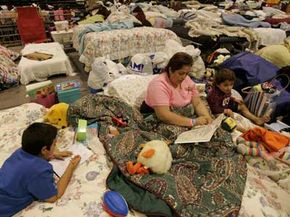When a hurricane barrels your way, you have a decision to make: Do I stay or do I go? If you live in a low-lying area, or near a lake, river or the sea, your choice is clear. If you're in an area that has any chance of flooding, you need to evacuate as soon as possible [source: Skinner].
Advertisement
However, if flooding poses no risk (check with your local emergency management office to make sure), and if you haven't been ordered to evacuate, you may choose to stay home, hunker down and ride out the storm. If you do stay, you'll have a better chance of survival if you're protected from wind-borne debris and projectiles like trees, branches, parts of houses, and even cars. You can get that protection in a stand-alone shelter outside your home or a fortified space inside your house, known as a safe room or in-residence shelter.
Stand-alone hurricane shelters are typically made of steel panels welded together into a box-shaped structure with a steel door and bolted to a concrete pad. Unless you have metalworking skills and tools, this is not a DIY project. You can expect to pay $5,000 and up for a shelter built to standards set by the Federal Emergency Management Agency (FEMA).
A stand-alone shelter strong enough to protect against a hurricane's fury could also be made of concrete fortified with reinforcing iron bars (known as rebar), fortified masonry blocks, or insulating concrete forms (foam molds into which concrete is poured, known as ICFs). To be built properly, a storm shelter can be designed by an engineer and built on-site by a contractor, or you can have a pre-fabricated unit delivered to your chosen site and assembled there. Companies that sell storm shelters include Armor Vault of Oklahoma City, Okla., and Steel Storm Shelters, based in Jackson, Tenn. These shelters are made for "extreme wind events" like tornadoes and hurricanes.
Now that we've convinced you to build some sort of hurricane shelter, how large should it be? It depends on the number of people in your household; FEMA suggests that your home hurricane shelter building have at least 10 square feet (.93 square meters) of space per person, so a shelter made to house a family of five would need to be at least 50 square feet (4.65 square meters). You'll need even more space than that if you have sick or shut-in relations, as each bedridden person needs 30 square feet (2.8 square meters). For an idea of what you're up against, consider that a typical two-car garage measures 400 square feet (37.2 square meters).
If you'd rather build a safe room inside your house, read on to the next page for some ideas.
Advertisement
